Hydrogen Detection with SAW Polymer/Quantum Dots Sensitive Films
Abstract
1. Introduction
2. Materials and Methods
3. Results and Discussion
4. Conclusions
Author Contributions
Funding
Acknowledgments
Conflicts of Interest
References
- Mujahid, A.; Dickert, F.L. Surface Acoustic Wave (SAW) for Chemical Sensing Applications of Recognition Layers. Sensors 2017, 17, 2716. [Google Scholar] [CrossRef] [PubMed]
- Ballantine, D.S.; White, R.M.; Martin, S.J.; Ricco, A.J.; Zellers, E.T.; Frye, G.C.; Wohtjen, H. Acoustic Wave Sensors, Theory, Design, and Physico-Chemical Applications; Academic Press: Cambridge, MA, USA, 1997. [Google Scholar]
- Choodum, A.; Keson, J.; Kanatharana, P.; Limsakul, W.; Wongniramaikul, W. Selective pre and post blast trinitrotoluene detection with a novel ethylenediamine entrapped thin polymer film and digital image colorimetry. Sens. Actuators B Chem. 2017, 252, 463–469. [Google Scholar] [CrossRef]
- Jasek, K.; Pasternak, M.; Grabka, M.; Neffe, S.; Zasada, D. Deposition of Polymer Sensor Films on SAW Surface by Electrospraying Technology. Arch. Acoust. 2017, 42, 507–513. [Google Scholar] [CrossRef][Green Version]
- Miu, D.; Birjega, R.; Viespe, C. Surface Acoustic Wave Hydrogen Sensors Based on Nanostructured Pd/WO3 Bilayers. Sensors 2018, 18, 3636. [Google Scholar] [CrossRef] [PubMed]
- Esmeryan, K.D. Application of Thin Metal Oxide Films in Acoustic Wave Chemical Sensors. Biosens. Bioelectron. 2015, 6, 163. [Google Scholar] [CrossRef]
- Constantinoiu, I.; Viespe, C. Detection of Volatile Organic Compounds Using Surface Acoustic Wave Sensor Based on Nanoparticles Incorporated in Polymer. Coatings 2019, 9, 373. [Google Scholar] [CrossRef]
- Sayago, I.; Fernández, M.; Fontecha, J.; Horrillo, M.; Vera, C.; Obieta, I.; Bustero, I. New sensitive layers for surface acoustic wave gas sensors based on polymer and carbon nanotube composites. Sens. Actuators B Chem. 2012, 175, 67–72. [Google Scholar] [CrossRef]
- Kim, W.; Jang, B.; Lee, H.-S.; Lee, W. Reliability and selectivity of H2 sensors composed of Pd Film nanogaps on an elastomeric substrate. Sens. Actuators B Chem. 2016, 224, 547–551. [Google Scholar] [CrossRef]
- Gonçalves, H.; Jorge, P.A.; Fernandes, J.; Da Silva, J.C.E.; Fernandes, J.R.A.; Da Silva, J.E. Hg(II) sensing based on functionalized carbon dots obtained by direct laser ablation. Sens. Actuators B Chem. 2010, 145, 702–707. [Google Scholar] [CrossRef]
- Li, M.; Kan, H.; Chen, S.; Feng, X.; Li, H.; Li, C.; Fu, C.; Quan, A.; Sun, H.; Luo, J.; et al. Colloidal quantum dot-based surface acoustic wave sensors for NO2-sensing behavior. Sens. Actuators B Chem. 2019, 287, 241–249. [Google Scholar] [CrossRef]
- Li, H.; Li, M.; Kan, H.; Li, C.; Quan, A.; Fu, C.; Luo, J.; Liu, X.; Wang, W.; Yang, Z.; et al. Surface acoustic wave NO2 sensors utilizing colloidal SnS quantum dot thin films. Surf. Coat. Technol. 2019, 362, 78–83. [Google Scholar] [CrossRef]
- De Vero, J.; Jasmin, A.; Dasallas, L.; Garcia, W.; Sarmago, R. Synthesis of Iron Oxide Nanostructures via Carbothermal Reaction of Fe Microspheres Generated by Infrared Pulsed Laser Ablation. Coatings 2019, 9, 179. [Google Scholar] [CrossRef]
- Kim, M.; Osone, S.; Kim, T.; Higashi, H.; Seto, T. Synthesis of Nanoparticles by Laser Ablation: A Review. KONA Powder Part. J. 2017, 34, 80–90. [Google Scholar] [CrossRef]
- Wang, W.; Liu, X.; Mei, S.; Jia, Y.; Liu, M.; Xue, X.; Yang, D. Development of a Pd/Cu nanowires coated SAW hydrogen gas sensor with fast response and recovery. Sens. Actuators B Chem. 2019, 287, 157–164. [Google Scholar] [CrossRef]
- Li, Z.; Yao, Z.; Haidry, A.A.; Plecenik, T.; Xie, L.; Sun, L.; Fatima, Q. Resistive-type hydrogen gas sensor based on TiO2: A review. Int. J. Hydrogen Energy 2018, 43, 21114–21132. [Google Scholar] [CrossRef]
- Nugroho, F.A.A.; Darmadi, I.; Cusinato, L.; Susarrey-Arce, A.; Schreuders, H.; Bannenberg, L.J.; Fanta, A.B.D.S.; Kadkhodazadeh, S.; Wagner, J.B.; Antosiewicz, T.J.; et al. Metal-polymer hybrid nanomaterials for plasmonic ultrafast hydrogen detection. Nat. Mater. 2019, 18, 489–495. [Google Scholar] [CrossRef]
- Willis, A.G.; Haron, S. Synthesis of composite thin-film polymer consisting of tungsten and zinc oxide as hydrogen gas detector. In Proceedings of the 7th Conference on Emerging Energy and Process Technology, Johor Bahru, Malaysia, 27–28 November 2018. [Google Scholar]
- Iftikhar, M.A.; Awattif, A.M. CdS/PMMA-based inorganic/organic heterojunction for H2S gas sensing. Chalcogenide Lett. 2017, 14, 133–138. [Google Scholar]
- Al-Mashat, L.; Tran, H.D.; Wlodarski, W.; Kaner, R.B.; Kalantar-Zadeh, K. Polypyrrole nanofiber surface acoustic wave gas sensors. Sens. Actuators B Chem. 2008, 134, 826–831. [Google Scholar] [CrossRef]
- Viespe, C.; Miu, D. Characteristics of Surface Acoustic Wave Sensors with Nanoparticles Embedded in Polymer Sensitive Layers for VOC Detection. Sensors 2018, 18, 2401. [Google Scholar] [CrossRef]
- Baik, K.H.; Jung, S.; Ren, F.; Pearton, S.J.; Jang, S. Moisture Insensitive PMMA Coated Pt-AlGaN/GaN Diode Hydrogen Sensor and Its Thermal Stability. ECS J. Solid State Sci. Technol. 2018, 7, Q3009–Q3013. [Google Scholar] [CrossRef]
- Hou, L.; Xu, B.; Kang, J.; Zhao, C.; Jin, S. Sensitivity-enhanced Fabry-Perot filled with PDMS temperature sensor based on Vernier effect. In Proceedings of the Asia Communications and Photonics Conference (ACP), Hangzhou, China, 26–29 October 2018. [Google Scholar] [CrossRef]
- Li, Y.; Shen, W.; Zhao, C.; Xu, B.; Wang, D.; Yang, M. Optical hydrogen sensor based on PDMS-formed double-C type cavities with embedded Pt-loaded WO3/SiO2. Sens. Actuators B Chem. 2018, 276, 23–30. [Google Scholar] [CrossRef]
- Campbell, C. Surface Acoustic Wave Devices and Their Signal Processing Applications; Academic Press: Cambridge, MA, USA, 1989. [Google Scholar]
- Sima, C.; Viespe, C.; Nicolae, I.; Grigoriu, C.; Prodan, G.; Ciupina, V.; Cismileanu, A.; Nistor, C.L.; Nicolae, C.-A.; Donescu, D. Functionalized Si/SiO2 quantum dots. SPIE Proc. 2007, 6785, 67850K. [Google Scholar]
- Benetti, M.; Cannatà, D.; Verona, E.; Palla Papavlu, A.; Dinca, V.; Lippert, T.; Dinescu, M.; Di Pietrantonio, F. Highly selective surface acoustic wave e-nose implemented by laser direct writing. Sens. Actuators B Chem. 2019, 283, 154–162. [Google Scholar] [CrossRef]
- Ghannam, M.T.; Esmail, M.N. Rheological Properties of Poly(dimethylsiloxane). Ind. Eng. Chem. Res. 1998, 37, 1335–1340. [Google Scholar] [CrossRef]
- Pawar, E. A Review Article on Acrylic PMMA. IOSR JMCE 2016, 13, 1–4. [Google Scholar] [CrossRef]
- Jakubika, W.; Urbańczyk, M.; Maciak, E.; Krzywiecki, M. Bi-layer nanostructures of CuPc and Pd in SAW and resistance hydrogen sensor. Sens. Actuator B Chem. 2012, 175, 255–262. [Google Scholar] [CrossRef]
- Marcu, A.; Viespe, C. Surface Acoustic Wave Sensors for Hydrogen and Deuterium Detection. Sensors 2017, 17, 1417. [Google Scholar] [CrossRef]
- Yang, L.; Yin, C.; Zhang, Z.; Zhou, J.; Xu, H. The investigation of hydrogen gas sensing properties of SAW gas sensor based on palladium surface modified SnO2 thin film. Mater. Sci. Semicond. Process. 2017, 60, 16–28. [Google Scholar] [CrossRef]
- Marcu, A.; Viespe, C. Laser-grown ZnO nanowires for room-temperature SAW-sensor applications. Sens. Actuators B Chem. 2015, 208, 1–6. [Google Scholar] [CrossRef]
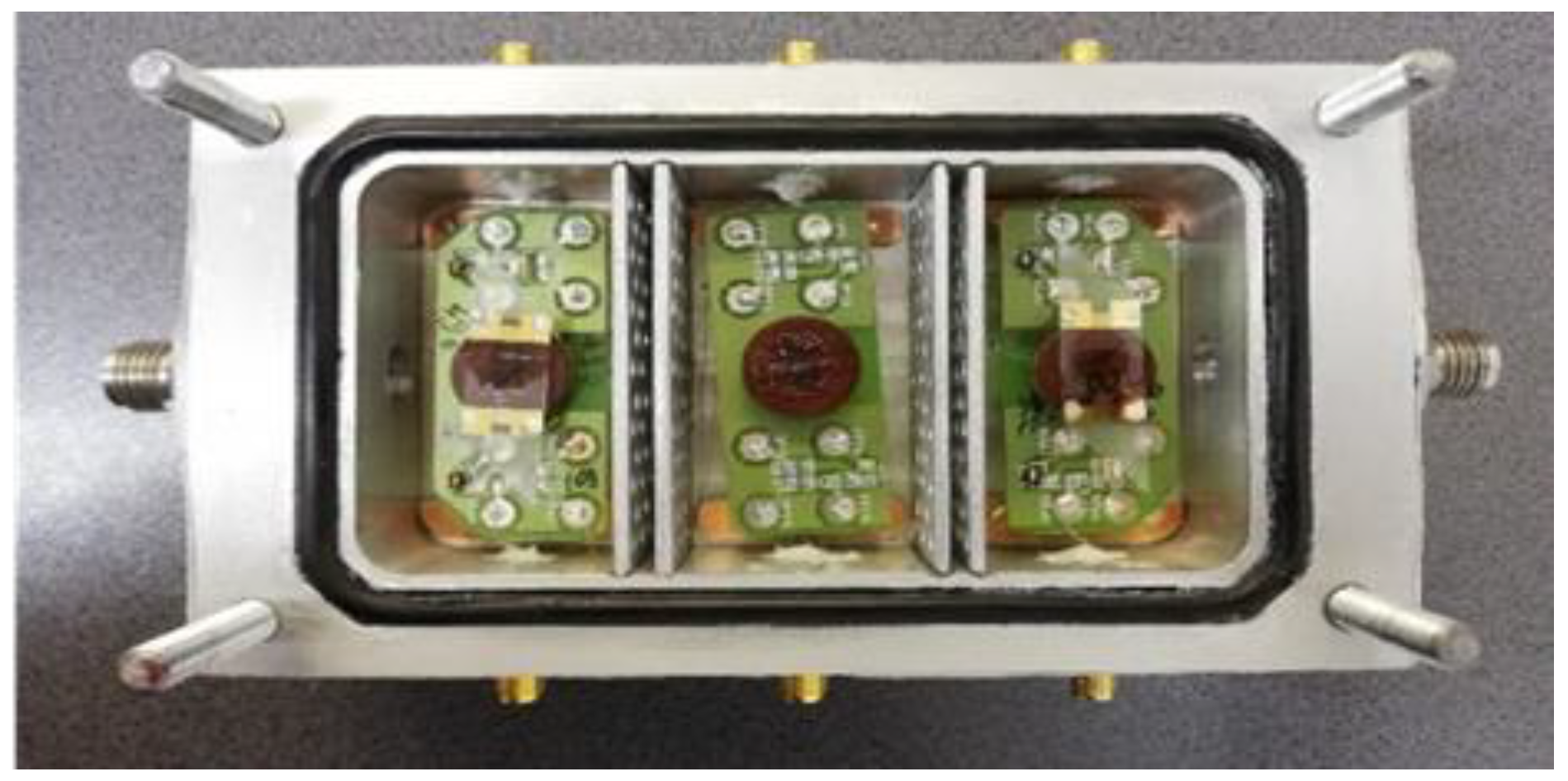
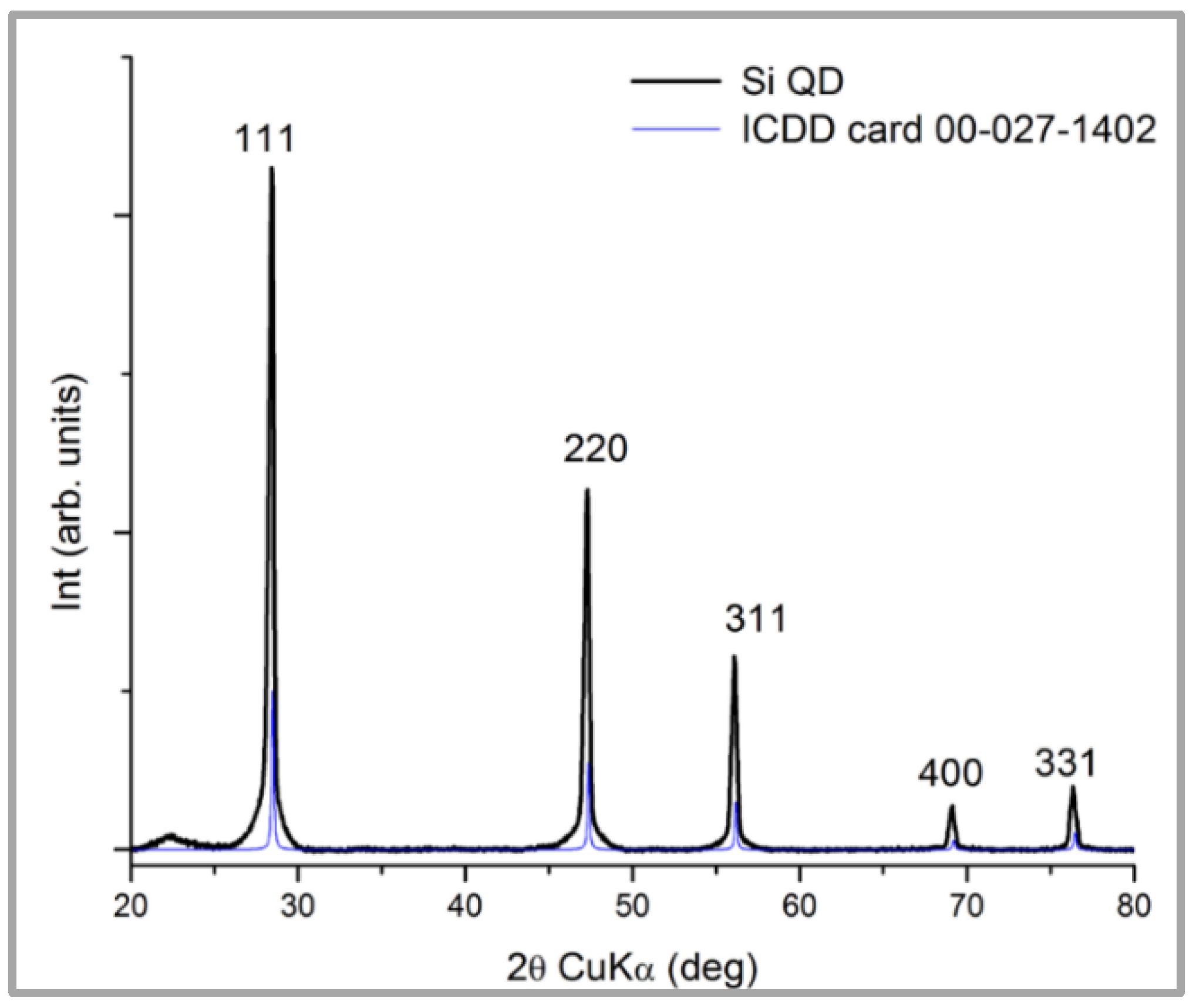


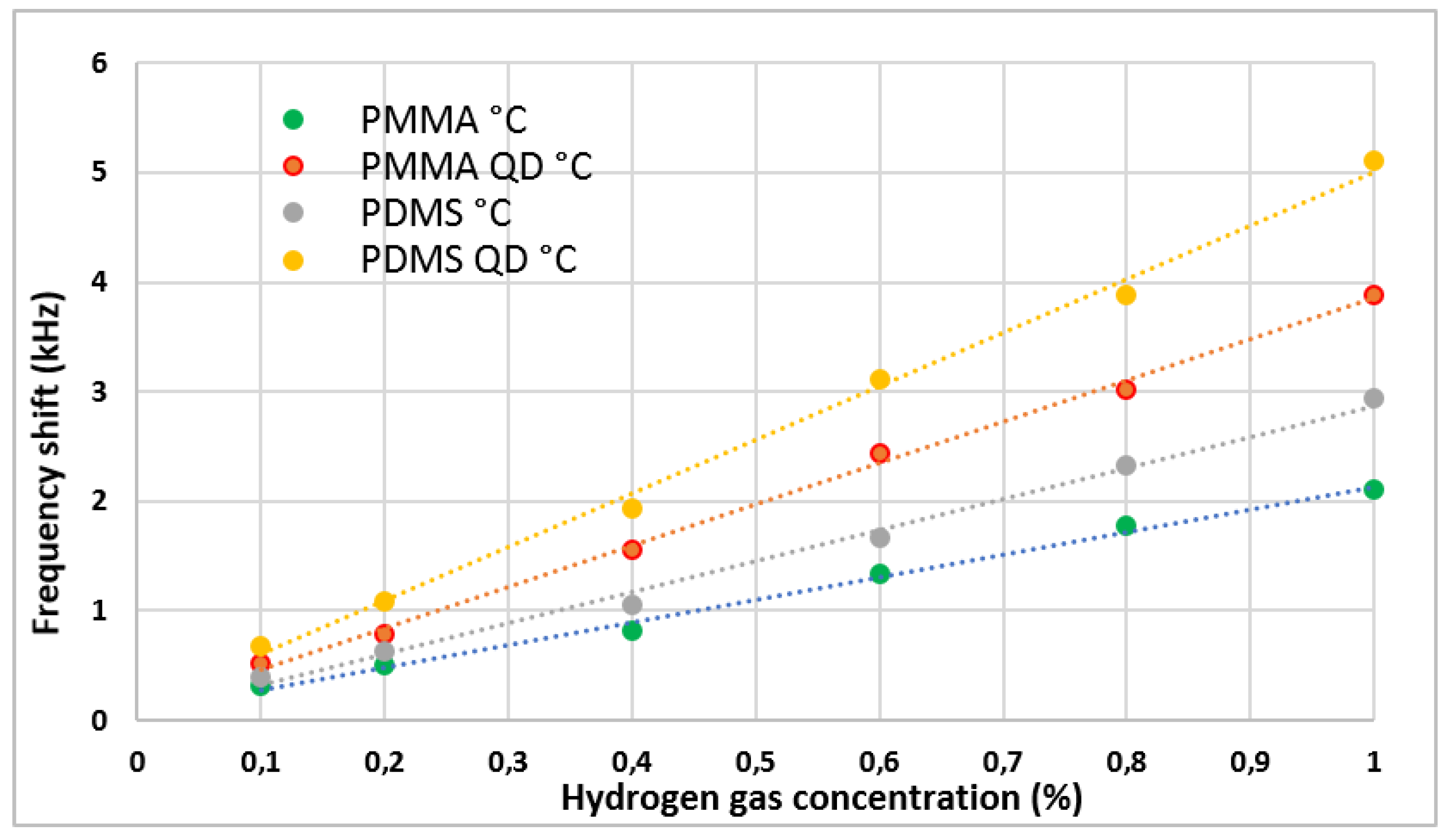
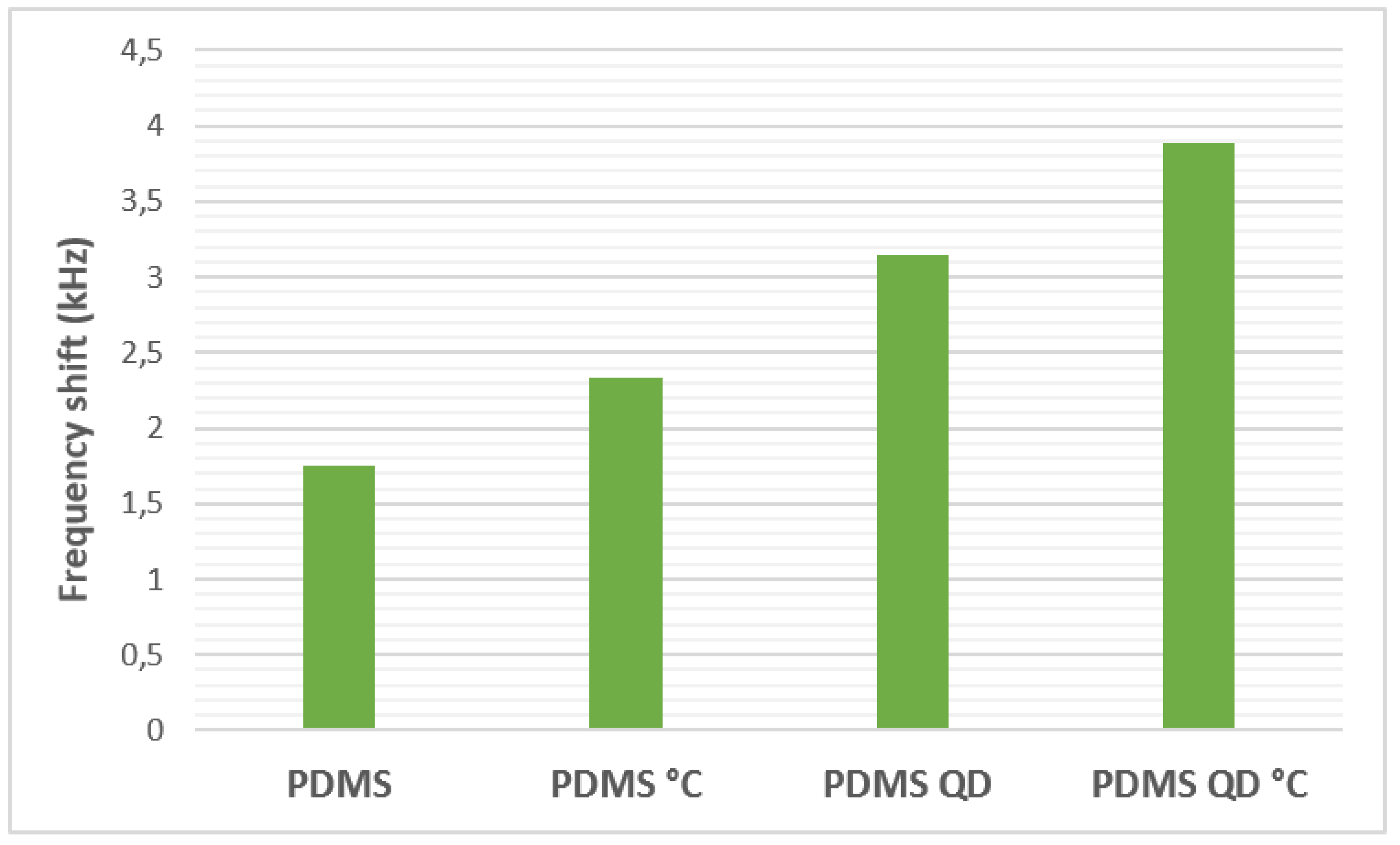
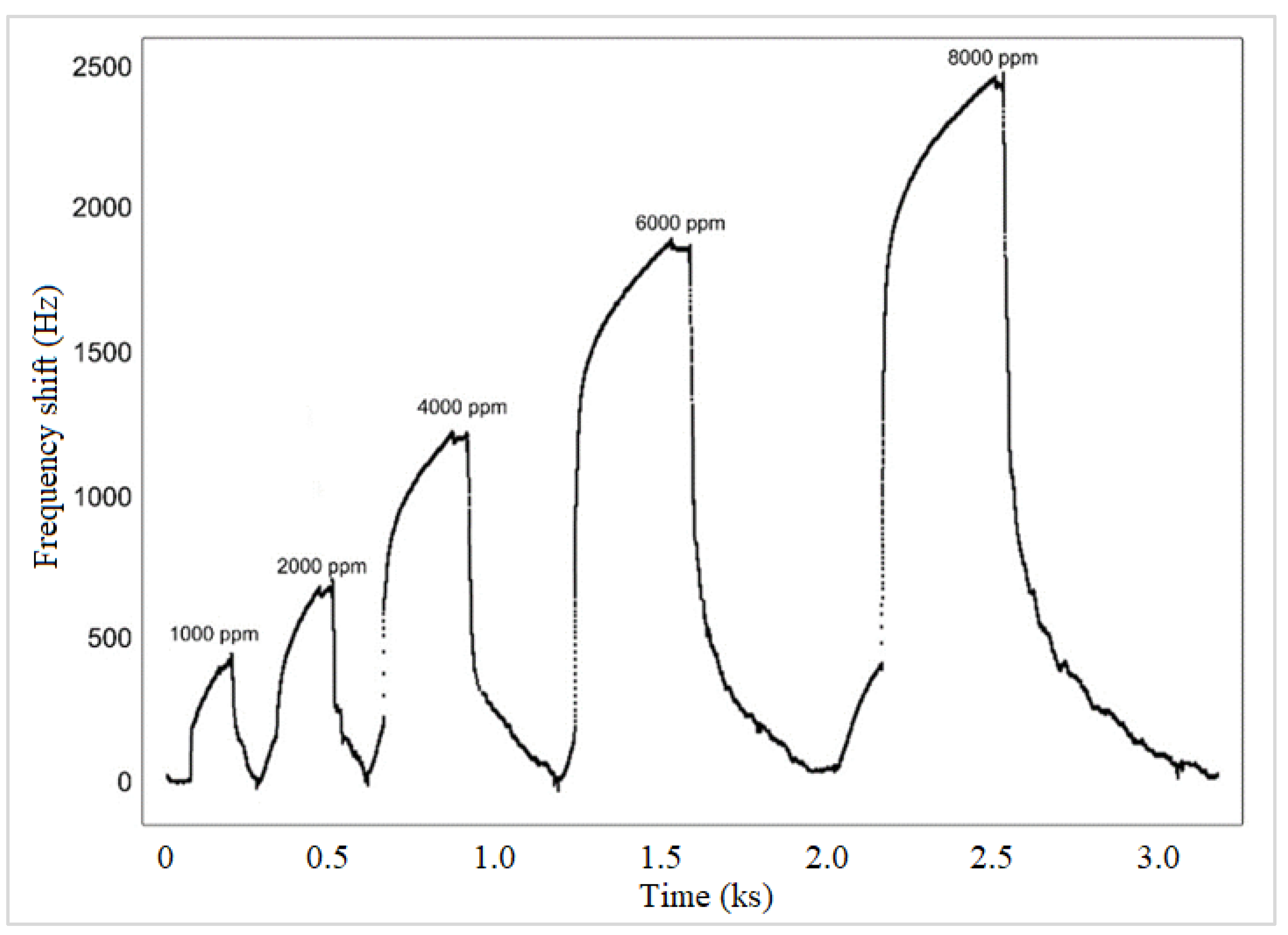
| Polymer | QDs | Thermal Treatment | Sensor Name |
|---|---|---|---|
| PMMA | Yes | No | PMMA QDs |
| Yes | PMMA QDs °C | ||
| No | No | PMMA | |
| Yes | PMMA °C | ||
| PDMS | Yes | No | PDMS QDs |
| Yes | PDMS QDs °C | ||
| No | No | PDMS | |
| Yes | PDMS °C |
| Sensor | Sensitivity Δf/c, Hz/ppm | LOD ppm | Noise Level Hz |
|---|---|---|---|
| PMMA | 0.19 | 1278 | 80 |
| PMMA QDs | 0.34 | 722 | |
| PMMA °C | 0.24 | 1037 | |
| PMMA QDs °C | 0.41 | 589 | |
| PDMS | 0.24 | 1008 | |
| PDMS QDs | 0.43 | 567 | |
| PDMS °C | 0.31 | 797 | |
| PDMS QDs °C | 0.54 | 452 |
| Sensitive Materials | Sensitivity | Limit of Detection | Working Temperature | Reference |
|---|---|---|---|---|
| Pd/WO3 | 0,13 Hz/ppm | 4540 ppm | Room temperature | [5] |
| CuPc/Pd | 1kHz to 5000 ppm | 370 °C | [30] | |
| ZnO nanowires | 0.015 Hz/ppm | 2117 ppm | Room temperature | [31] |
| Pd modified SnO2 | 1159 kHz to 2000 ppm | - | 175 °C | [32] |
| ZnO nanowires | 0,62 | 2253 ppm | Room temperature | [33] |
| PDMS with Si/SiO2 QDs | 0,54 | 452 ppm | Room temperature | The present work |
© 2019 by the authors. Licensee MDPI, Basel, Switzerland. This article is an open access article distributed under the terms and conditions of the Creative Commons Attribution (CC BY) license (http://creativecommons.org/licenses/by/4.0/).
Share and Cite
Constantinoiu, I.; Viespe, C. Hydrogen Detection with SAW Polymer/Quantum Dots Sensitive Films. Sensors 2019, 19, 4481. https://doi.org/10.3390/s19204481
Constantinoiu I, Viespe C. Hydrogen Detection with SAW Polymer/Quantum Dots Sensitive Films. Sensors. 2019; 19(20):4481. https://doi.org/10.3390/s19204481
Chicago/Turabian StyleConstantinoiu, Izabela, and Cristian Viespe. 2019. "Hydrogen Detection with SAW Polymer/Quantum Dots Sensitive Films" Sensors 19, no. 20: 4481. https://doi.org/10.3390/s19204481
APA StyleConstantinoiu, I., & Viespe, C. (2019). Hydrogen Detection with SAW Polymer/Quantum Dots Sensitive Films. Sensors, 19(20), 4481. https://doi.org/10.3390/s19204481






